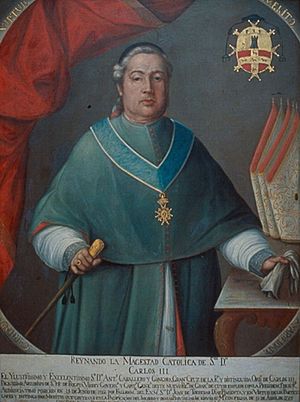Antonio Caballero y Góngora facts for kids
Antonio Caballero y Góngora was an important Spanish leader in the Americas. He was born on May 24, 1723, in Priego de Córdoba, Spain. He became a Roman Catholic priest and later a very high-ranking official. From 1782 to 1789, he served as the viceroy of New Granada. This area included what is now Colombia and Ecuador. He died on March 24, 1796, in Córdoba, Spain.
Contents
Early Life and Studies
Antonio Caballero was born into a noble family in Córdoba, Spain. His parents were Juan Caballero y Espinar and Antonia de Góngora. He started his studies in Córdoba. When he was 15, he received a scholarship to study theology in Granada. He finished his studies in 1744 and became a priest on September 19, 1750.
Antonio was a very educated man who loved art. He collected paintings by famous artists like Velázquez and Rubens. His library had many modern books on different subjects. He also collected old coins, which is called numismatics.
In 1775, he was chosen to be the bishop of Mérida in Yucatán. This area was part of New Spain, which is now Mexico. He sailed to Cuba in 1776 for his consecration. He brought many books, art, and coins with him. He also helped reorganize a school that had problems after the expulsion of the Jesuits in 1767.
Archbishop of Bogotá
In 1777, King Charles III chose Antonio Caballero to be the archbishop of Santa Fé de Bogotá. This city was in the Viceroyalty of New Granada. The Pope also approved this choice. Antonio arrived in Bogotá on March 5, 1778.
He worked hard to bring peace after the Comunero Revolt. Because of his good work, King Charles made him a member of the Order of Carlos III. The king also appointed him as the viceroy of New Granada.
As archbishop, he did a lot of important work for the church. He changed how church taxes (tithes) were collected. He also helped create new church areas in Mérida (Venezuela) and Cuenca (Ecuador).
The Comunero Revolt
In 1780, a big uprising called the Comunero Revolt started in New Granada. This happened around the same time as another revolt led by Túpac Amaru in Peru. The main reason for the revolt was new taxes ordered by King Charles III.
The Spanish Crown sent Juan Francisco Gutiérrez de Piñeres to the colony in 1777. He was an inspector who put new taxes on things like tobacco and alcohol. He also set up new tax offices.
The revolt began in Simacota. Many different groups of people joined, including Mestizos, Criollos, and Indigenous people. About 20,000 men marched towards the capital city. They wanted the new taxes to be removed. The viceroy at the time, Manuel Antonio Flórez, had left the capital.
The main court, called the Audiencia, and Archbishop Caballero met with the rebels. The meeting took place in Zipaquirá, not far from the capital. The rebels demanded that the new taxes be removed and old ones lowered. Archbishop Caballero convinced the Audiencia to agree to all the rebels' demands. An agreement was signed on June 7, 1781. The archbishop even swore on the gospels to keep the promise. The rebels then went home.
However, once back in Bogotá, the Audiencia and the archbishop went back on their word. They said the agreement was not valid. The Comuneros rose up again, but this time they were less successful. The revolt was put down with force, and their leaders were captured and executed.
Viceroy of New Granada
After the previous viceroy resigned and his replacement died, Archbishop Caballero y Góngora was chosen to be the new interim Viceroy of New Granada in 1782.
It was his job to bring peace to the viceroyalty. He announced a pardon from the king for those who had rebelled. He also made the colonial army stronger. He sent Franciscan missionaries to areas that had rebelled to teach peace and obedience to the king. He also asked the king to get rid of some of the recent tax changes.
Viceroy Caballero worked hard to modernize New Granada. He helped the economy, industries, and arts grow. He also strongly supported the Royal Botanical Expedition of 1783, led by José Celestino Mutis. This expedition studied the plants of the region. In 1782 and 1783, he also had to deal with a smallpox outbreak.
In 1783, his temporary appointment as viceroy became permanent. In 1784, he went to Cartagena to help Indigenous people settle in towns. He also tried to stop an Indigenous rebellion in Darién, but this project was not successful. He founded new missions in Casanare and San Martín.
In 1787, he asked to leave his positions, and the king agreed the next year.
In 1788, he was appointed bishop of Córdoba in Spain. He sailed back to Spain in April 1789. In Córdoba, he started a School of Fine Arts. He also gave his large art collection to the city.
Antonio Caballero y Góngora died in Córdoba in 1796.
The plant genus Gongora, which is a type of orchid mostly found in Colombia, was named after him.
See also
 In Spanish: Antonio Caballero y Góngora para niños
In Spanish: Antonio Caballero y Góngora para niños


